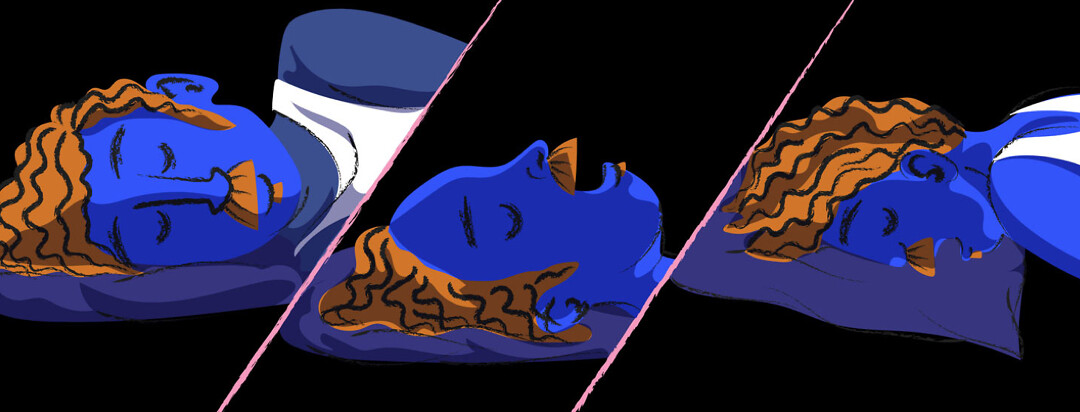Could Treating Sleep Apnea Be as Simple as Changing Positions?
Most people think treatment for obstructive sleep apnea (OSA) only involves devices such as a PAP machine or oral devices. But for some, treatment may be far simpler, with less investment in time and patience: positional therapy.
Why sleep position matters
If you’ve had a sleep study, then you’re likely aware that your test data tracked your body position. If you don’t normally sleep on your back (supine), you were likely asked to do so during the test. For many, this results in struggles to sleep. Why? People avoid back sleep at home for all kinds of reasons. One is pain; the other is – you guessed it – problems breathing.
The sleep technologist who asks you to sleep on your back isn’t trying to torture you. They’re simply measuring the severity of your OSA when you sleep supine. It turns out that when you sleep supine, your OSA severity may run far worse than if you slept on your right or left side.1
Also, if people with suspected OSA never sleep on their backs during a study, they may actually fail to receive an accurate diagnosis – and the necessary treatment it requires. Like failing to treat other chronic conditions such as type 2 diabetes, failure to treat OSA leads to unhealthy and dangerous repercussions down the line.1
Position-dependent OSA
It’s estimated that more than half of all cases of OSA are “position-dependent,” meaning the severity of apneas significantly changes depending upon sleeping position. A person with position-dependent OSA may experience an increase of 50 percent or more apneas in their total AHI, or apnea-hypopnea index, while sleeping on their back.2
That can make a big difference in both diagnosis and treatment. A person with an AHI of 5 while side sleeping, who isn’t tested while sleeping supine, may not receive a diagnosis at all. Meanwhile, they may actually test as having an AHI of 10 to 15, which would require therapy to treat.
Not every person with OSA has position-dependent OSA. For those who do, positional therapy may be an option.
Can positional therapy treat sleep apnea?
Maybe. When you sleep on either the left or right side, your upper airway is less likely to collapse. That collapse is what causes snoring and apneas. For this reason, doctors might first explore positional therapy with their lower-severity, position-dependent OSA patients.
Positional therapy utilizes strategies that encourage side sleeping, such as:
- Positioning yourself to side-sleep against a body pillow, which prevents you from turning over onto your back.
- Sewing a tennis ball into your sleep shirt so that, should you turn over, you find the tennis ball too uncomfortable to sleep on, forcing you to the other side instead.
- Wearing an appliance around the neck or waist that vibrates an alarm when you shift to back sleeping, which forces you to remain asleep on your side.
- Strapping on a special pillow or backpack to prevent you from assuming a supine position.
Research shows that these and other positional therapy strategies help reduce AHI in people with OSA.3
Positional therapy is easy to use and low cost
What’s also worth considering here is adherence rates. Think about it this way: A person who treats their position-dependent OSA with a therapy they can easily afford and adapt to is more likely to remain adherent to their therapy than someone who struggles to afford and adapt to their therapy. Positional therapy demands far less from a user than positive airway pressure (PAP) therapy does.
AHI matters with positional therapy
It’s important to note that disease severity plays a big role in the effectiveness of positional therapy. If your AHI is higher, avoiding the supine position is critical. Otherwise, you’ll still keep having apneas if you don’t practice positional therapy with regularity and vigilance.
It’s common for someone with a higher AHI to combine both positional therapy and the use of a PAP machine or oral device to achieve a more comprehensive therapeutic outcome. Meanwhile, someone who only experiences apneas while sleeping supine may find that all they need is positional therapy to keep their airways unobstructed during sleep.4
As with any therapy, your best option depends upon factors like severity and sleep position relevant to your unique OSA experience. Your sleep physician is your best resource for determining if positional therapy is right for you.
What about stomach sleepers?
The jury remains divided on whether someone with OSA will sleep better when prone (on their stomach). While sleeping prone may reduce snoring by using gravity to prevent the tongue and other tissues from sliding into the upper airway, many who sleep on their stomach experience neck pain and problems maintaining breathing with their face tucked into a pillow.4
What is your preferred sleeping position? Please share your sleep apnea story or comment below.

Join the conversation